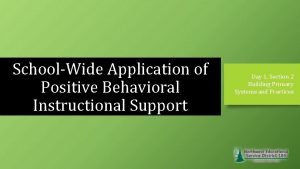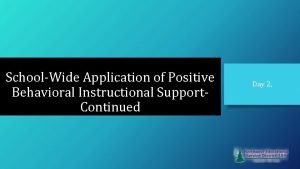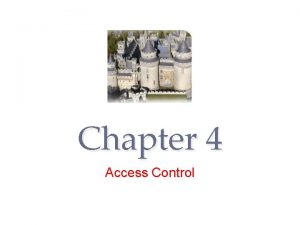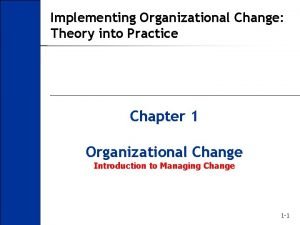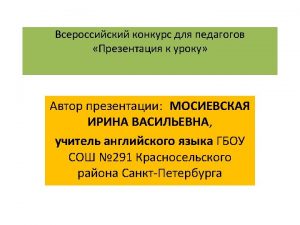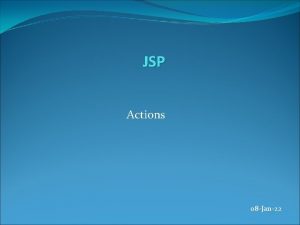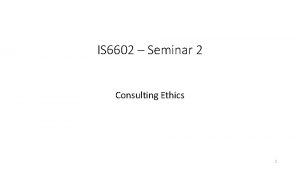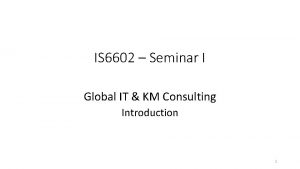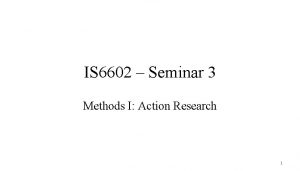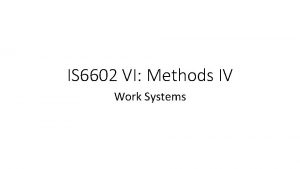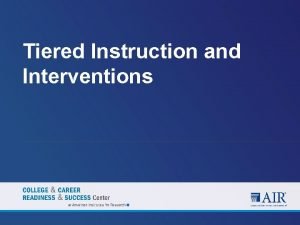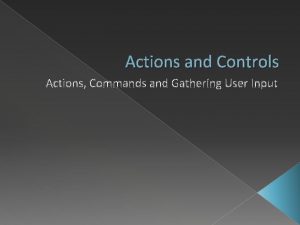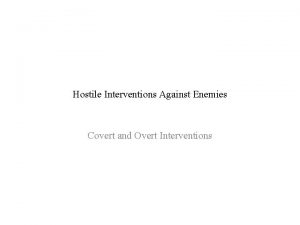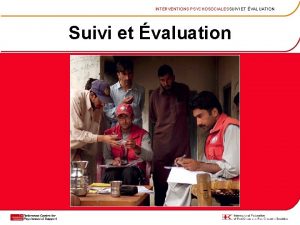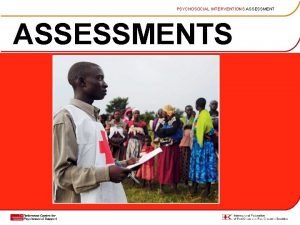IS 6602 IX Implementing Interventions Taking Actions and


































- Slides: 34

IS 6602 IX: Implementing Interventions Taking Actions and Dealing with Resistance 1

Recap • Your proposal to the client has been accepted • They like your proposed strategy for radical change • You are confident that the employees have the right skills and are willing to learn new techniques • Now you just have to make it happen! • **I wish that life was so simple** 2

Intervention Activities • Translating Plans into Actions • Meeting a client’s changing needs • The role of theory in action – Documenting a chaotic process – Linking actions to theory • Employee Resistance – It almost always happens • Impacts and measures 3

Translating Plans into Actions • This is the first hurdle to overcome • A plan that meets a client’s needs is not the same as a plan that can be acted upon • So once you get the green light, you need to create a new plan, a working plan, to get the work done • This plan will be detailed and technical • It will have a time line and clear responsibilities for individual consulting team members 4

Operational Plans • You may find it useful to bring in Project Management tools and techniques like PERT and Gantt Charts • You will need to identify a list of all the different actions to take, and indicate who does what • You may need to go back to the client for details, but not too often 5

Operational Plans • The first actions that you take may be communication actions – Talk to the employees who will be doing the work, whose lives will be turned upside down – If the employees are on your side, your life will be MUCH easier – Try to ensure that the employees benefit because you do not want them to resist later • Preparing the employees for change is the first part of change 6

Example - Nestle • When Nestle implemented a new ERP in the late 1990 s, they introduced the technology first – without changing the processes • This caused a lot of headaches, and high employee turnover • Employees were very unhappy because they felt that they had not been consulted 7

Example - IKEA • When IKEA implemented a new ERP system in the early 2000 s, they assumed that the software would fit the work processes undertaken by employees around the world • Unfortunately, that fit was not always there and some employees found that the software did not support their work at all. • Naturally employees were unhappy – and had to find new ways to get work done 8

The Speed of Change • How fast you intervene, and how many processes simultaneously, depends on how much time you have • Ideally, you start slowly and build up – A very quick change process has a high chance of failure • Work on the processes first, not the technology • Processes may need to be re-engineered before new technology can be introduced 9

A Phased Approach • Working bit by bit may be more sensible, even though systems and processes are often interlinked • Look at the Work Systems Snapshot – see if you can identify specific work processes that can be reorganised, so as to fit the new structure and new technology • When the process is ready and the employees are trained, then the technology can come next 10

Clients’ Needs Always Change • This is a sad fact of organisational life • If your consulting project is due to last two years, you should not expect that the agreed scope and requirements will survive intact • Revisions will be needed • It will be easier to modify the intervention if you are in close contact with the client – Weekly meetings to review progress and also keep in touch with organisational realities – Modifications may have cost implications 11

Changing Requirements • So long as the basic aim of the project is to continue, you are OK, but it may be that the client wants to abandon the project entirely or else make major changes • This may violate any contact you have signed • You need to look at the legal and contract issues very carefully 12

Interruptions • Clients can also cancel meetings or actions at short notice – For instance they have a major internal problem or an important visitor is in town • Consultants should cover their own interests. The client is paying for your time, even if you are not doing anything • If you have to cancel flights, hotels, etc. then the client must pay to cover your losses 13

Example • This kind of interruption happened to me several times • In Beijing, I was told an hour before a meeting that it was cancelled. • In Shanghai, I was given a week’s notice, but I still had to cancel bookings • Perhaps interruptions are unavoidable, but consultants should be compensated for this – There is also the lost opportunity cost 14

The Role of Theory in Action • Action Research specifies that a theory should be used for both problem diagnosis and to underpin the actions that are taken • The theory may usefully serve as a guide to the actions themselves • The theory may also guide you to collect certain kinds of data that you will need later to assess impacts 15

Theories and Clients • Clients are seldom interested in theory: they want solutions • But this does not mean theories are useless • The practical aspects of theories need to be translated into a form that clients can understand • Hopefully this is not just common sense but actually adds something that the client did not know before 16

For Example 1 - TAM • TAM (Technology Adoption Model) suggests that when people find a technology is easy to use and useful, then they are more likely to form the behavioural intention to use it • That sounds very simple and common sense • But it may be that employees do NOT find a technology to be easy to use OR useful, yet they still have no choice about using it! • So part of the action may be to ensure that the technology imposed on employees by the CIO is both easy to use and useful • Ensuring this requires employee involvement in the technology selection, deployment and testing processes 17

Apart from Usefulness and Ease of Use… • What other factors may influence employees’ willingness to adopt and use a new technology? • Knowing the answer may be very helpful for a consultant • Alternatively, what constraints may limit the extent to which employees use a technology? 18

For Example 2 - TMT • TMT (Transactive Memory Theory) is a theory about how we rely on other people’s memories for knowledge in order to get things done • TMT suggests that the strength of our network is important – i. e. WHO we know is just as important as WHAT we know • When you know more people you can work more effectively • So we might recommend an ACTION that encourages employees to develop better networks • But that is not easy in China where guanxi dominates and I suppose that we can’t order employees to develop more or better guanxi 19

TMT and China • TMT suggests that it is enough to know who knows • But in China it is not enough – you also need guanxi with the person who knows • Without guanxi, you have to contact the remote person through multiple intermediaries, which is rather inefficient • How can we encourage people to build more network connections? 20

For Example 3 - PET • PET (Punctuated Equilibrium Theory) explains that in a stable situation (organisation, work team, etc. ) it is possible to stimulate radical change that will have a dramatic effect on performance • The radical change needs to be an intervention that challenges the existing structures, proposing a radically better way of working • Such a change also requires a change agent, a person who intervenes with those actions • The consultant can be one example of such a change agent 21

PET and China • I have used PET on several occasions when I do AR in organisations • PET can be risky because if the intervention fails then the situation may get worse, not better • PET requires explicit management approval • I see myself as the change agent, but I still have to get the employees to agree 22

Context and Proof of Concept • The client firm operates in a particular context – Culture, values, environment, law, etc. • You will have ideas about a solution to meet their needs, but translating that idea from your head to practice requires some concrete evidence to demonstrate that it can work – This can be done on a small scale first – this is what we mean by proof of concept – The Proof of Concept will also help you to build trust with the client – Evaluation of the Proof of Concept can lead to some fine tuning BEFORE you move to a larger scale of implementation 23

Achieving Proof of Concept • It is important to choose a context where you have a high chance of success – This can be where employees really want to be the guinea pigs, the first to try out the new work practice and the new technology • If your proof test fails, it is very hard to continue elsewhere in the organisation – Indeed, the whole situation in the company may become toxic! 24

Employee Resistance • Employee resistance is an unfortunate fact of consulting life • No matter how much we work with employees nor how much they agree that they like a new system, this is NEVER a guarantee that they will actually use it • Employees may not want to tell their real feelings to your face, but they will demonstrate their feelings in their actions 25

Employee Resistance • A common reason for resistance is inertia – People resist change – It is easier not to change one’s style of work – An innovation must be dramatically better for people to adopt it – So yes, perhaps your new technology is better (or better for management) but it does not really make the employees’ life easier, so they resist – How much better does the new technology have to be in order to increase the chance that people use it? 10%? 1000%? 26

For Example • In a PR firm in Beijing, I was the change agent (PET) intervening by implementing a new KM system with a pilot in one team • I had strong support from the CEO • I seemed to have support from the team leader – she would not contradict her boss • But after we implemented, hardly anyone actually used it! 27

Post-Implementation Interview • I went back to the team leader and this is what she said: – “I am not an IT expert. I am an employee who makes use of IT when it is useful. But I don’t see why I should ask my colleagues to use a new IT that does not make our lives much easier or better. Incremental improvements are inadequate justification for change. Your new system makes my work more difficult, not more easy. So I won’t use it or require my colleagues to use it. ” 28

Retrospectively… • I would reflect that the team where we tried out the proof of concept was not a good choice – It was selected by the CEO because, as he said “they have lots of problems”! • Well, such a difficult team may be a high risk team for a proof of concept initiative – I asked the CEO to choose an easier, more enthusiastic team – but he refused. – In the end, perhaps the failure was not so surprising 29

Dealing with Resistance • The best way is not to let it develop at all • This requires very close working with employees • Given the tendency to resist at the very last minute (when it seems too late to make changes), you need to maintain very close contact with the employees at all times • You may want to involve them in throughout the AR cycle, from diagnosis, through planning, intervention and testing. 30

Evaluation • The last two stages of the AR cycle are evaluation and learning • First, we need to compare the before intervention and after intervention states – Can we see any demonstrated improvements? – Can we measure them? – How do the employees feel? • Second, we have to assess what we learned through the whole consulting process 31

Impacts • Ideally the specific problem that was targeted has been addressed • But quite often it may be only partly addressed, or not at all • Perhaps the intervention failed or the employees resisted • In this case, it may be necessary to make a 2 nd attempt at an intervention – More diagnosis, planning, action 32

Reports and Lessons Learned • The consultant usually has a duty to provide the client with a report at the end of the project – This may summarise what was done, what was successful, what still needs to be done • The consultant should also prepare a report for internal use so as to inform future consulting projects – This can be more honest about the events! – It may also include reports on individual team members 33

Ethical Issues • • Participation Competence Persistence Protecting Rights and Duties 34
 Effective aperture of antenna
Effective aperture of antenna Flexibility matrix
Flexibility matrix Friis transmission formula
Friis transmission formula Management issues central to strategy implementation
Management issues central to strategy implementation Implementing strategies: management and operations issues
Implementing strategies: management and operations issues Chapter 7 strategic management
Chapter 7 strategic management Setting prices and implementing revenue management
Setting prices and implementing revenue management Designing and implementing branding strategies
Designing and implementing branding strategies Designing and implementing brand architecture strategies
Designing and implementing brand architecture strategies Crm project design and planning process
Crm project design and planning process Matching structure with strategy
Matching structure with strategy Toyota brand architecture
Toyota brand architecture Ch 7
Ch 7 Ekg rhythms and interventions
Ekg rhythms and interventions Positive behavioral interventions and supports
Positive behavioral interventions and supports Positive behavioral interventions and supports
Positive behavioral interventions and supports Developing and evaluating complex interventions
Developing and evaluating complex interventions Dementia treatments and interventions near patterson
Dementia treatments and interventions near patterson Implementing hrd programs pdf
Implementing hrd programs pdf Retail management notes doc
Retail management notes doc What is documentation portfolio
What is documentation portfolio Qsen teamwork and collaboration definition
Qsen teamwork and collaboration definition Challenges of implementing predictive analytics
Challenges of implementing predictive analytics Bert spector
Bert spector Implementing strategies marketing finance/accounting
Implementing strategies marketing finance/accounting Is the traditional method of implementing access control
Is the traditional method of implementing access control Project selection and portfolio management
Project selection and portfolio management Implementing nfpa 1600 national preparedness standard
Implementing nfpa 1600 national preparedness standard Implementing organizational change theory into practice
Implementing organizational change theory into practice Ubmta
Ubmta Nfpa 1600 business continuity programs
Nfpa 1600 business continuity programs Implementing firewall technologies
Implementing firewall technologies Safewards 10 interventions
Safewards 10 interventions Planning is a category of nursing behaviors in which:
Planning is a category of nursing behaviors in which: What is nursing process
What is nursing process














